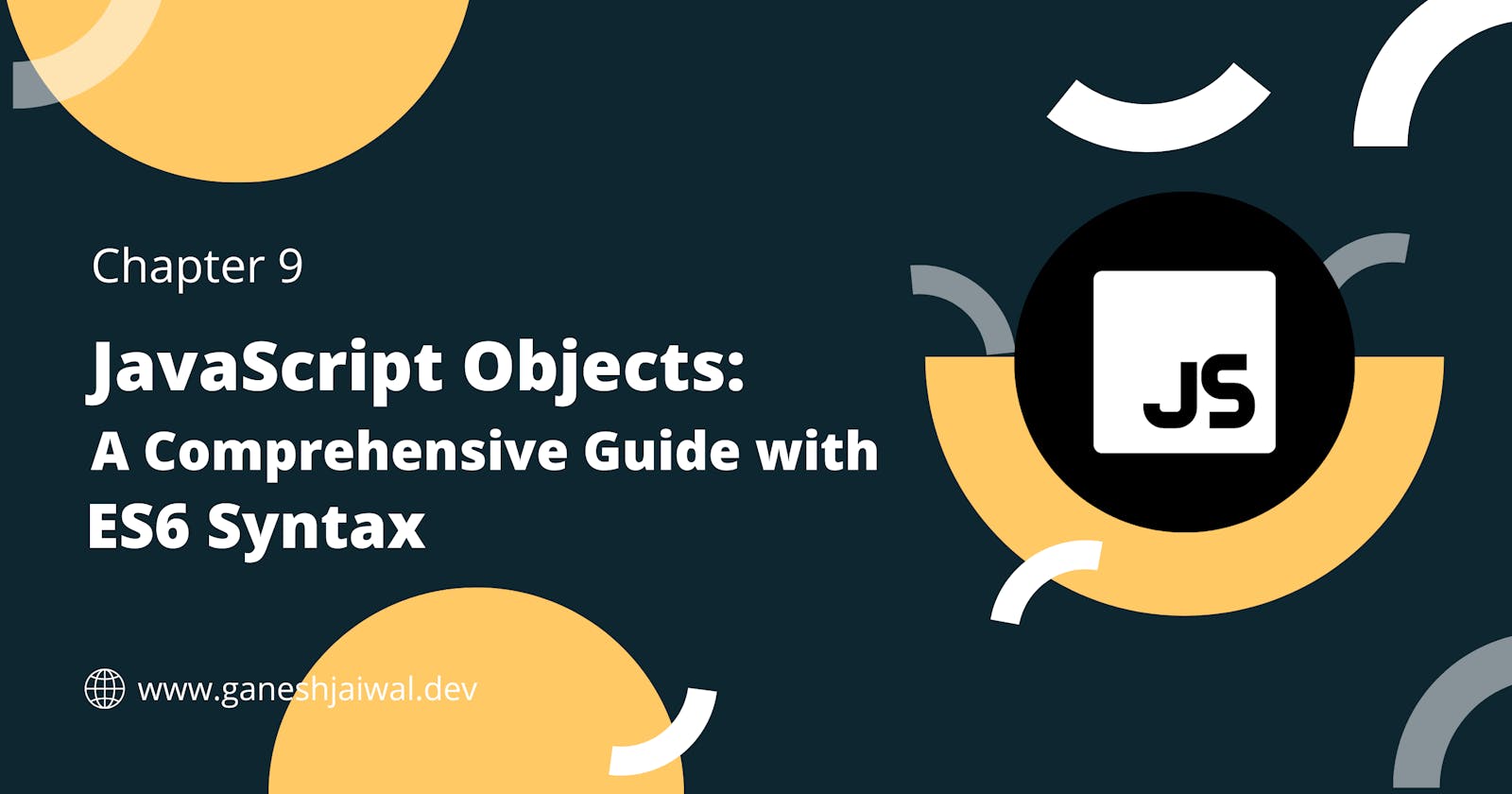Welcome to a comprehensive journey through the world of JavaScript objects. In this extensive guide, we'll explore JavaScript objects in-depth, utilizing both Vanilla JS and modern ES6 syntax. Our aim is to equip you with a deep understanding of objects, their creation, manipulation, and various methods. Whether you're a beginner or an experienced developer, this article will serve as a valuable resource in your web development endeavors.
Now, let's dive into the details of JavaScript objects.
1. Introduction to Objects
JavaScript objects are versatile data structures used for organizing and storing data efficiently. Unlike primitive data types, such as numbers and strings, objects can hold various data types, including other objects, functions, and arrays. They are fundamental to JavaScript and are key components of web development.
Example: Creating a Simple Object (ES6 Syntax)
const person = {
firstName: 'John',
lastName: 'Doe',
age: 30,
};
In this example, person is an object with three properties: firstName, lastName, and age, each representing distinct pieces of information.
2. Creating Objects
JavaScript offers multiple methods for creating objects, allowing developers to choose the most suitable approach for their needs.
a. Object Literal Notation
The simplest method is using object literal notation:
const person = {
firstName: 'John',
lastName: 'Doe',
age: 30,
};
b. Constructor Functions
Constructor functions enable you to create objects with shared methods:
function Person(firstName, lastName, age) {
this.firstName = firstName;
this.lastName = lastName;
this.age = age;
}
const person = new Person('John', 'Doe', 30);
c. ES6 Class Syntax
ES6 introduced class syntax for object creation, providing a structured approach:
class Person {
constructor(firstName, lastName, age) {
this.firstName = firstName;
this.lastName = lastName;
this.age = age;
}
}
const person = new Person('John', 'Doe', 30);
d. Object.create() Method
The Object.create() method allows you to create objects with a specified prototype:
const personPrototype = {
greet() {
console.log(`Hello, my name is ${this.firstName}`);
},
};
const person = Object.create(personPrototype);
person.firstName = 'John';
person.lastName = 'Doe';
person.age = 30;
3. Querying and Setting Properties
Accessing and modifying object properties can be accomplished through dot notation or square bracket notation.
Example: Querying and Setting Properties
// Querying properties
const name = person.firstName; // Accessing the 'firstName' property
console.log(name); // Output: 'John'
// Setting properties
person.age = 31; // Modifying the 'age' property
console.log(person.age); // Output: 31
4. Deleting Properties
To remove a property from an object, use the delete operator:
Example: Deleting a Property
delete person.lastName; // Deleting the 'lastName' property
5. Testing Properties
You can check if an object contains a specific property using the hasOwnProperty() method:
Example: Testing for a Property
const hasAge = person.hasOwnProperty('age');
console.log(hasAge); // Output: true
6. Enumerating Properties
JavaScript provides various methods to iterate over object properties, including for...in loops and the Object.keys() method.
a. Using for...in Loops
for (const key in person) {
console.log(`${key}: ${person[key]}`);
}
b. Using the Object.keys() Method
const keys = Object.keys(person);
for (const key of keys) {
console.log(`${key}: ${person[key]}`);
}
7. Extending Objects
Dynamically adding properties and methods to objects enhances their functionality.
Example: Extending an Object (ES6 Syntax)
class Person {
constructor(firstName, lastName, age) {
this.firstName = firstName;
this.lastName = lastName;
this.age = age;
}
greet() {
console.log(`Hello, my name is ${this.firstName}`);
}
}
const person = new Person('John', 'Doe', 30);
person.greet(); // Output: 'Hello, my name is John'
8. Serializing Objects
Serialization converts objects into a format suitable for storage or transmission. JavaScript provides the JSON.stringify() method for this purpose.
Example: Serializing an Object
const jsonPerson = JSON.stringify(person);
console.log(jsonPerson);
9. Object Methods
JavaScript objects come with several built-in methods to perform various operations.
a. Object.values() Method (ES6 Syntax)
This method returns an array of an object's values:
const values = Object.values(person);
console.log(values); // Output: ['John', 30]
b. Object.entries() Method (ES6 Syntax)
This method returns an array of key-value pairs as arrays:
const entries = Object.entries(person);
console.log(entries); // Output: [['firstName', 'John'], ['age', 30]]
c. Object.assign() Method (ES6 Syntax)
Object.assign() combines multiple objects into one:
const info = { job: 'Developer', city: 'New York' };
const merged = Object.assign({}, person, info);
console.log(merged);
10. Extended Object Literal Syntax (ES6 Syntax)
ES6 introduces shorthand property names for concise object creation:
Example: Shorthand Property Names (ES6 Syntax)
const name = 'Alice';
const age = 25;
const person = { name, age };
console.lo(person.name); // Alice
console.lo(person.age); // 25
11. Summary
This comprehensive guide has provided a thorough exploration of JavaScript objects, encompassing both Vanilla JS and modern ES6 syntax. Proficiency with objects is essential for web development, enabling the creation of dynamic and interactive web applications.
As you advance in your web development journey, remember that objects are a foundational concept. Leveraging their power effectively will significantly enhance your coding skills. Keep experimenting, practicing, and exploring the endless possibilities that JavaScript objects offer in the ever-evolving landscape of web development. Happy coding!

